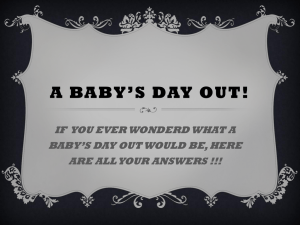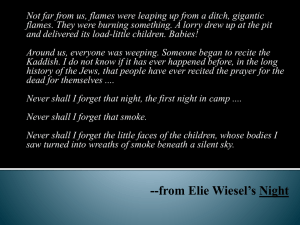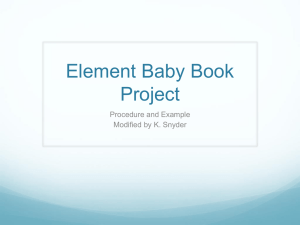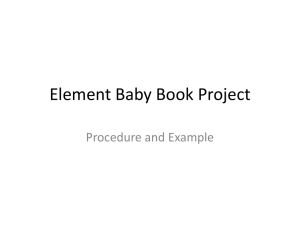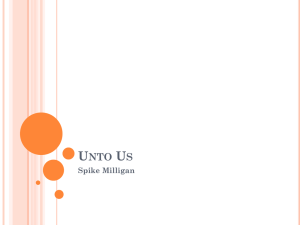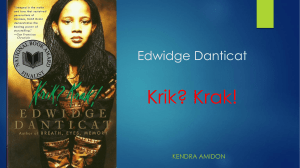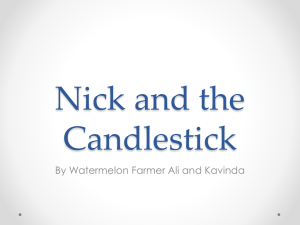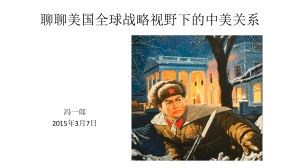Morning Song
advertisement
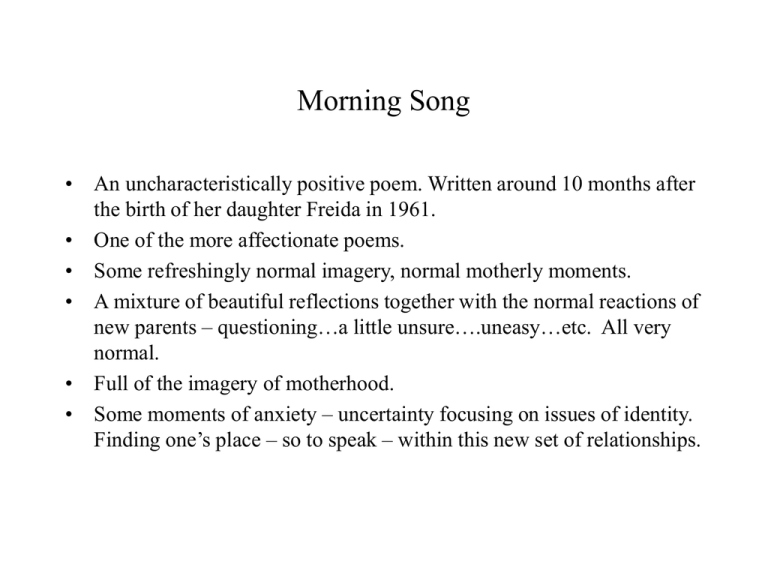
Morning Song • An uncharacteristically positive poem. Written around 10 months after the birth of her daughter Freida in 1961. • One of the more affectionate poems. • Some refreshingly normal imagery, normal motherly moments. • A mixture of beautiful reflections together with the normal reactions of new parents – questioning…a little unsure….uneasy…etc. All very normal. • Full of the imagery of motherhood. • Some moments of anxiety – uncertainty focusing on issues of identity. Finding one’s place – so to speak – within this new set of relationships. 1-2 • The child is precious and the product of love. • The simile of the fat gold watch brilliantly captures the pregnancy, the pricelessness of the child and the passing of time (9 months ?) • The slap from the midwife followed by the baby’s signals the baby’s arrival into the world. Note the baby’s “cry” as she takes her place among the elements. The child has arrived to take her place in the world. • The “Our” of line 4 refers to the parents and their reaction to the arrival of the baby. The child’s nakedness represents her fragility or vulnerability. The parents wish to protect the child but feel a little helpless, a little out of her depth, perhaps. Her “nakedness shadows our safety. We stand around blankly as walls. 3 • A complex image addressing the relationship between Plath and her baby. – She’s reflectring on who she is in relation to this new human being…what does it mean – being a mother? – The actual image details how a cloud begins to empty itself to become a pool on the ground far below. – The pool then becomes a reflective surface mirroring the remains of the cloud above which is still emptying iteslf. This is not about personal annihilation – the cloud ceasing to be as the pool is formed. • She is in awe of her child. She sees it as something greater than herself. She does not want to see that she was the creator, but merely a door to allow the child entry. She sees birth as a natural, earthy act that is greater than her. She IS the mother but she is a player in the larger action. This section is about humility. 4• A change in tone here. The uneasiness of the first three stanzas is replaced by the protectiveness of a mother. A more confident tone. • We see the mother – child relationship as it ought to be. • A domestic scene with Plath’s description of her baby daughter’s breathing at night. Notice the wispy delicacy of the child’s “moth breath”. • Note the sense of fragility as the breath “flickers”, (like a candle perhaps) – first time parents often experience anxiety about their child’s breathing at night….constantly listening to make sure the little one is okay. – A perfectly normal anxiety – far removed from the intense anguish of other poems. – The flat pink roses may represent the baby’s mouth, lips. – The sound is described as “a far sea” in the poet’s ear. • The final two stanzas run into each other and depict Plath nursing her baby as dawn breaks and the baby makes its little noises – its “morning song”. 5-6 • The child’s voice heard again with her “cry” in line 13. Note the other references to voices in 2 and 4. • Plaths’s self portrait is striking. In response to the baby’s cry… – – – – – She stumbles from bed “cow heavy”…..obviously a reference to breastfeeding Dressed in a floral “Victorian nightgown” A very domestic image – a mother nursing her baby. The image of the baby’s open-mouth “clean as a cat’s”, is usually said to represent the poet’s ‘amused delight’ or her ‘joy at the baby’s every movement’. It’s a little unclear. Either way, it’s certainly interesting. •Finally, dawn break as the “window square whitens” and we get to hear the “morning song” of the title – the sounds made by the baby. •These are the “clear vowels” which, she tells us, “rise like ballons”. •The poem has moved from uncertainty, to confidence, to delight at the beautiful child and the noises she makes in the early morning. •The “cry” from earlier has now become “a handful of notes” – the “Morning song”. Points to note • Note the uncertain, slightly detached, anxious tone in 1 – 3 • Note how this changes to the confident, affectionate, attentive tone / mother of 4 – 6. • Striking imagery – Fat gold watch….statue in a drafty museum….the complex “cloud” image (3)….”cow-heavy in (her) floral Victorian nightdress”…..mouth “clean as a cat’s”….the childs ‘song’ rising “like balloons”, etc. • Stark contrast between the normality of this poem and the pain/anguish of the others. • Various sound effects used for emphasis and effect. – Assonance…long “O” sounbds in 1. “going…gold….footsoles” – Long vowel sounds in 3 to emphasise the slow ‘process’ described. – Alliteration in 5. “cry…cow…clean…cat’s” Conclusion • A reassuringly ‘normal’ poem dealing with the complex mother – child relationship. • Unusual, sometimes striking imagery. • Tone changes for anxious/detached to confident and affectionate.



